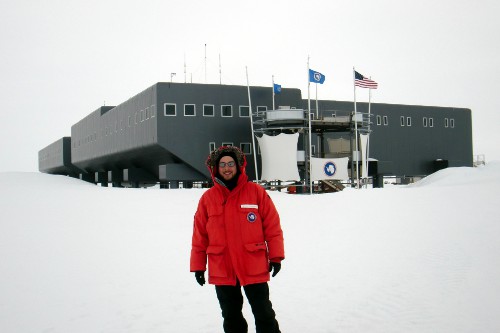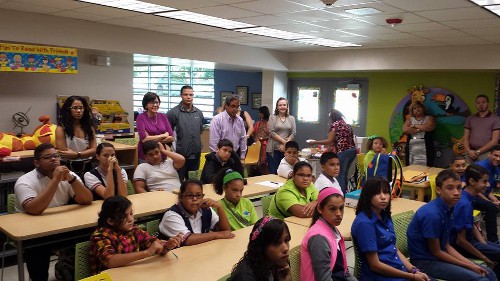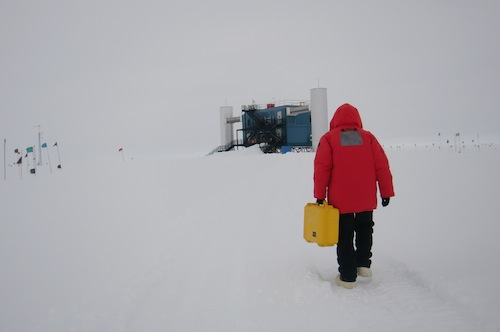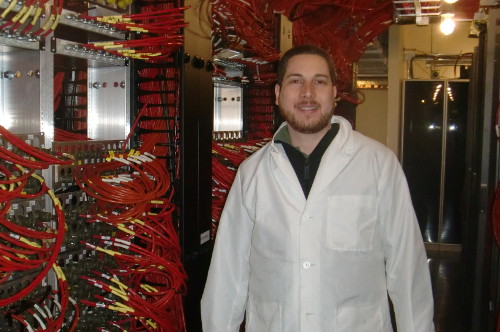
I started my day at 3:00 am with the second IceCube webcast, which was done in Spanish and was hosted by Dr. Silvia Bravo of the Wisconsin IceCube Particle AstrophysicsBranch of astronomy devoted to the study of the physical characteristics and composition of objects in the sky, including how much light the stars give off and the size, mass, and temperature of planets and stars. Center (WIPAC). The webcast ran for a full hour and fifteen minutes—including an extensive questions-and-answers session—and was an absolutely enjoyable experience. We also had Stephan (here at the South Pole) and Megan (from Madison, Wisconsin) assisting with the webcast. I used my 30-minute presentation to give a summary of my work with PolarTREC so far, since my selection as a participant back in November 2013 to my current work with IceCube at the South Pole.



Among the attendance were Gretchen from G Works, teachers and students from Pedro Rivera Molina school in Juncos, Puerto Rico—where I teach—, Sandra from Alfonso Díaz Lebrón school—also in Juncos and where I have also taught—, Ruth from the Arecibo ObservatoryA location used for observing terrestrial and/or celestial events., and Rachelis from Niños de Nueva Esperanza community project in Levittown, Puerto Rico. We also had the Hon. Ángel R. Peña-Ramírez of the Puerto Rico House of Representatives and Mr. Rubén Correa of the Juncos Municipal Education Department, as well as key officers from the Puerto Rico Department of Education including Ingrid Mercado who heads the 21st Century Community Learning Centers federal initiative.


The IceCube team has been working intensively with the IceTop experiment, so I went out again with Sam and walked over like one kilometer to one of the IceTop stations. We checked the equipment there and then took a couple of data acquisition modules (DAQs) back to the IceCube Laboratory (ICL). We carried them by foot for like half a kilometer.


We then arrived at the ICL's second level, where the IceCube operator's room and server room are located. While there I learned that Hans got his all-sky camera up and running, and that James has been successful with his calibrations and is now almost done. So, everything is coming together for the IceCube project, and it makes me proud to be part of this effort.



El día comenzó a las 3:00 am con mi participación en el segundo webcast de IceCube, realizado en español y con la presencia como moderadora de la Dra. Silvia Bravo del Wisconsin IceCube Particle Astrophysics Center (WIPAC). El webcast —el cual fue una experiencia fabulosa— se extendió por una hora y quince minutos e incluyó una extensa sesión de preguntas. Contamos también con la ayuda de Stephan (aquí en el polo sur) y de Megan (desde Madison, Wisconsin). Mi presentación de 30 minutos la utilicé para resumir mis trabajos con PolarTREC, desde mi selección como participante en noviembre de 2013 hasta mis trabajos actuales aquí en el polo sur.



Entre la audiencia se encontraba Gretchen de G Works, maestros y estudiantes de la escuela SU Pedro Rivera Molina en Juncos, Puerto Rico —institución donde enseño—, Sandra de la escuela Alfonso Díaz Lebrón —también en Juncos y donde igualmente he enseñado—, Ruth del Observatorio de Arecibo y Rachelis del proyecto comunitario Niños de Nueva Esperanza en Levittown, Puerto Rico. Tuvimos también al honorable Ángel R. Peña Ramírez de la Cámara de Representantes de Puerto Rico, así como al Sr. Rubén Correa del Departamento de Educación Municipal de Juncos, y a varios funcionarios del Departamento de Educación de Puerto Rico incluyendo a Ingrid Mercado (directora) del programa federal 21st Century Community Learning Centers.


El personal de IceCube ha estado trabando últimamente con gran intensidad en el experimento IceTop. Esto motivó que saliera nuevamente hoy a trabajar con el IceTop. Caminamos aproximadamente un kilómetro y una vez allí verificamos el equipo. Posteriormente nos llevamos algunos módulos de adquisición de datos (DAQ) de vuelta al laboratorio IceCube (ICL), lo cual requirió medio kilómetro más a pie.


Nos dirigimos a la segunda planta del ICL, donde quedan el salón de servidores y la sala operacional. Allí nos dijeron que Hans ya ha completado la instalación de su cámara de gran angular, e igualmente que James ha podido realizar sus calibraciones y está ya a punto de terminar. O sea, todo va cayendo en su sitio para el proyecto IceCube y me resulta muy grato poder decir que he sido parte de este esfuerzo.




Comments